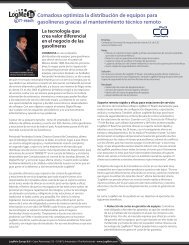LogMeIn Hamachi Network Types
LogMeIn Hamachi Network Types
LogMeIn Hamachi Network Types
- No tags were found...
You also want an ePaper? Increase the reach of your titles
YUMPU automatically turns print PDFs into web optimized ePapers that Google loves.
<strong>LogMeIn</strong> <strong>Hamachi</strong>Getting Started Guide
ContentsWhat Is <strong>LogMeIn</strong> <strong>Hamachi</strong>?...........................................................................................3Who Should Use <strong>LogMeIn</strong> <strong>Hamachi</strong>?.......................................................................................................3The <strong>LogMeIn</strong> <strong>Hamachi</strong> Client........................................................................................4About the Relationship Between the Client and Your <strong>LogMeIn</strong> Account.................................................4About the <strong>Hamachi</strong> Virtual IP Address......................................................................................................5<strong>LogMeIn</strong> <strong>Hamachi</strong> <strong>Network</strong> <strong>Types</strong> ...............................................................................6About Mesh <strong>Network</strong>s..............................................................................................................................6About Hub-and-Spoke <strong>Network</strong>s.............................................................................................................6About Gateway <strong>Network</strong>s.........................................................................................................................7<strong>LogMeIn</strong> <strong>Hamachi</strong> Subscription <strong>Types</strong>.........................................................................9How to Change or Purchase <strong>Hamachi</strong> Subscriptions..............................................................................9How to Purchase Subscriptions from the <strong>LogMeIn</strong> Website..............................................................10How to Purchase Subscriptions from the <strong>Hamachi</strong> Client..................................................................10Managing <strong>LogMeIn</strong> <strong>Hamachi</strong> Clients and <strong>Network</strong>s.................................................11<strong>LogMeIn</strong> <strong>Hamachi</strong> Security..........................................................................................12<strong>LogMeIn</strong> <strong>Hamachi</strong> and Firewalls.............................................................................................................12Installing <strong>LogMeIn</strong> <strong>Hamachi</strong>........................................................................................13<strong>Hamachi</strong> System Requirements..............................................................................................................13How to Sign up for a <strong>LogMeIn</strong> ID...........................................................................................................13How to Install the Client to a Local Computer........................................................................................14How to Deploy the Client to a Remote Computer..................................................................................14How to Install a <strong>Hamachi</strong> Client in Client-Only mode.............................................................................15How to Update the <strong>Hamachi</strong> Client........................................................................................................15Managing <strong>LogMeIn</strong> <strong>Hamachi</strong> <strong>Network</strong>s.....................................................................16How to Join an Existing <strong>Network</strong>............................................................................................................16How to Add a <strong>Hamachi</strong> <strong>Network</strong>............................................................................................................16How to Add a <strong>Hamachi</strong> <strong>Network</strong> from the Client....................................................................................17How to Approve or Reject Join Requests...............................................................................................17How to Delete a <strong>Network</strong>........................................................................................................................18How to Leave a <strong>Network</strong>.........................................................................................................................18<strong>LogMeIn</strong> <strong>Hamachi</strong> Glossary.........................................................................................19Legal Notice..................................................................................................................21ii<strong>LogMeIn</strong> <strong>Hamachi</strong> Getting Started Guide
What Is <strong>LogMeIn</strong> <strong>Hamachi</strong>?<strong>LogMeIn</strong> <strong>Hamachi</strong> is a virtual networking service that can be set up in minutes and enables secureremote access to your business network anywhere there is an Internet connection.Unlike traditional hardware and software based VPN systems, <strong>Hamachi</strong> is an on-demand virtualnetworking service that allows you to focus your time and energy on providing the remote connectionsyour users and systems need, and not the technology or infrastructure you are using to support them.Who Should Use <strong>LogMeIn</strong> <strong>Hamachi</strong>?Here are a few examples of how you can take advantage of <strong>Hamachi</strong>.IT Support: Building a Mobile Office LANMany mobile workers use their laptops mobile devices in the office while connected to their company'sshared resources (file servers, network printers, mail servers, etc.). But if a user moves away fromthe local network, he will no longer be able to access these resources. Software that is configuredto work inside the office becomes useless outside the office.Using <strong>Hamachi</strong>, mobile workers become members of a <strong>Hamachi</strong> network wherein all shared resourcesare also network members. As a result, network configurations can remain unchanged. <strong>Hamachi</strong> setsup exactly the same networking environment for the mobile user no matter where he is.Tip: Hub-and-spoke and gateway are the best networking modes for this scenario.IT Support: Setting Up <strong>Network</strong> Access for Home WorkersHome workers can be more productive when they have secure access to shared IT resources. Usingthe <strong>Hamachi</strong> client, home workers gain a secure tunnel directly into their company's network. Theycan work from home and still access the resources they need.Tip: Hub-and-spoke and gateway are the best networking modes for this scenario.Outsourced IT: Managing Multiple <strong>Network</strong>sA service provider with a number of administrators on his team wants to set up and maintain multiple<strong>Hamachi</strong> networks for multiple customers. He uses <strong>LogMeIn</strong> Central to create <strong>Hamachi</strong> networks,deploy <strong>Hamachi</strong> clients, and apply default and custom settings for each customer. He can alsomanage other administrators in his organization, generate client activity reports, and manage networkactivity.Small to Medium Sized Organizations: Virtual LANOrganizations without a physical LAN can use the mesh network type to set up a virtual corporateLAN.Copyright © 2015 <strong>LogMeIn</strong>, Inc.3
The <strong>LogMeIn</strong> <strong>Hamachi</strong> ClientThe term <strong>Hamachi</strong> client refers to both the <strong>Hamachi</strong> software itself and any computer or smartphonewith <strong>Hamachi</strong> client software installed. With proper permission from network owners, <strong>Hamachi</strong> clientscan become members of any <strong>Hamachi</strong> network.Figure 1: The <strong>LogMeIn</strong> <strong>Hamachi</strong> client for WindowsFigure 2: The <strong>LogMeIn</strong> <strong>Hamachi</strong> client for MacAbout the Relationship Between the Client and Your <strong>LogMeIn</strong> AccountThe <strong>Hamachi</strong> client can be used in Client-only (unattached) mode as a stand-alone service with norelation to a <strong>LogMeIn</strong> account, or in web management mode as an attached member of a <strong>LogMeIn</strong>account.4<strong>LogMeIn</strong> <strong>Hamachi</strong> Getting Started Guide
Client-only mode: UnattachedThe term Unattached client refers to any <strong>Hamachi</strong> client that has not been added to a <strong>LogMeIn</strong>account and is being used in Client-only mode. Unattached clients cannot be managed on the webusing the My <strong>Network</strong>s page or <strong>LogMeIn</strong> Central. It can still join existing networks and create meshnetworks.Web management mode: AttachedThe term Attached client refers to any <strong>Hamachi</strong> client that has been added to a <strong>LogMeIn</strong> account.Any <strong>LogMeIn</strong> account holder can manage attached clients on the web using the My <strong>Network</strong>s page,while <strong>LogMeIn</strong> Central subscribers can use <strong>LogMeIn</strong> Central.About the <strong>Hamachi</strong> Virtual IP AddressEvery <strong>Hamachi</strong> client has one virtual IPv4 (IP) address in the 25.x.x.x range and one IPv6 address.The virtual IP address is globally unique and is used to access the client from any other <strong>Hamachi</strong>network with at least one common mesh or hub-and-spoke network.Copyright © 2015 <strong>LogMeIn</strong>, Inc.5
<strong>LogMeIn</strong> <strong>Hamachi</strong> <strong>Network</strong> <strong>Types</strong><strong>LogMeIn</strong> <strong>Hamachi</strong> provides three network types for flexibility in meeting diverse use case scenarios.They differ mainly in network topology.<strong>Hamachi</strong> clients can be members of any network; however, depending on the network owner's<strong>Hamachi</strong> subscription, networks have the following limitations:•Free subscription allows you to have five members in a network•Standard subscription allows you to have 32 members in a network•Premium subscription allows you to have 256 members in a network•Multi-network subscription or a <strong>LogMeIn</strong> Central subscription allows you to have 256 members inall your networksFor information about subscription types, see <strong>LogMeIn</strong> <strong>Hamachi</strong> Subscription <strong>Types</strong> on page 9.About Mesh <strong>Network</strong>sIn a mesh network, every member is connected to every other member.Organizations without a physical LAN can use the mesh network type to set up a virtual corporateLAN.Mesh is also the typical choice for gamers, because network games constantly have to broadcasttheir current status to all other participants in the game.Figure 3: Mesh networkNote: Mesh is the only network type that can be created directly from the <strong>Hamachi</strong> clientinterface.About Hub-and-Spoke <strong>Network</strong>sIn a hub-and-spoke network, one or more computers act as hubs, while other clients connect asspokes. Spokes connect to hubs, but never to each other.Hub-and-spoke is typically used when a workstation (spoke) needs to connect only to servers (hubs).For example, in a library, the catalog is a hub while workstations accessing the catalog are spokes.Hub-and-spoke is ideal if you want strict control over connections between network members.6<strong>LogMeIn</strong> <strong>Hamachi</strong> Getting Started Guide
Figure 4: Hub-and-spoke networkImportant: If you set every member of a hub-and-spoke network to be a hub, you essentiallyturn the network into a mesh network. Similarly, if you set only spokes, your members will beunable to make a connection.About Gateway <strong>Network</strong>sUse the gateway network type to provide transparent access to your entire network from a centralized<strong>Hamachi</strong> gateway. Members of a gateway network, such as mobile workers, will see one computeracting as a gateway towards an entire LAN, thus making all network resources accessible.Figure 5: Gateway networkTip: Theoretically, a hub-and-spoke network would also be a good choice for enabling mobileLAN access; however, all shared resources would also need to be running the <strong>Hamachi</strong> clientand be set up as hubs. This is fine insofar as these shared resources are servers with a <strong>Hamachi</strong>compatible operating system; however, the gateway network remains the best option since<strong>Hamachi</strong> currently cannot be installed on network devices such as printers, routers, accesspoints, etc.Important: Mac hosts cannot act as gateway nodes.CharacteristicsThe gateway network type is a hybrid of the meshed and hub-and-spoke network types:•As in a hub-and-spoke network, one computer acts as a hub (the gateway), while members act asspokes•There can only be one gateway, which is typically a permanently online server connected to theLAN•The number of members is virtually unlimited since even network devices that are not running the<strong>Hamachi</strong> client can be considered members•Each member (<strong>Hamachi</strong> client) will see the gateway and the other members of the gateway's LAN•<strong>Hamachi</strong> clients will not see each other in a gateway networkRestrictionsFor technical and security reasons there are strict rules for both the gateway and members:Copyright © 2015 <strong>LogMeIn</strong>, Inc.7
•The gateway cannot be a member of any other network•Members can join more than one gateway network, but can only be online in one network at a time.Gateway members can also be members of multiple non-gateway networks•The gateway cannot be a workstation that is the member of a domainRole of the <strong>Hamachi</strong> Client in a Gateway <strong>Network</strong>•Gateway network members and the gateway device itself must be running the <strong>Hamachi</strong> client•<strong>Network</strong> devices that are physically connected to the LAN do not need to run the <strong>Hamachi</strong> clientto be made accessible to gateway network membersAddressingGateway networks integrate smoothly into the LAN in terms of addressing. 25.x.x.x addresses arenot available for a gateway network. Instead, the local address space is used.8<strong>LogMeIn</strong> <strong>Hamachi</strong> Getting Started Guide
<strong>LogMeIn</strong> <strong>Hamachi</strong> Subscription <strong>Types</strong>Every <strong>Hamachi</strong> user must have either a paid or free subscription to join or create <strong>Hamachi</strong> networks.<strong>LogMeIn</strong> <strong>Hamachi</strong> offers the following subscriptions:•Free subscription allows you to have five members in a network•Standard subscription allows you to have 32 members in a network•Premium subscription allows you to have 256 members in a network•Multi-network subscription or a <strong>LogMeIn</strong> Central subscription allows you to have 256 members inall your networksNote: The current and maximum number of network members are displayed on the <strong>Hamachi</strong>client next to name of the network. For example, 11/256 means that there are 11 members ina network that can have up to 256 members.What if I do not want to renew my subscription?Standard, Premium, and Multi-network subscriptions are paid subscriptions thatallow you to have more than five members in your network. If your network hasmore than five members, you should take the following into consideration beforeyou cancel your subscription:•Your network will not accept any new members.•Only five members will be active. Other members will be disabled (offline) in yournetwork until you resolve this issue by purchasing a subscription or evictingnetwork members.•Your network will still be fully functional but only for five randomly selectedmembers.•You can renew your expired subscription any time.What if I never had a paid subscription?For free networks, only five members remain active and you are unable to addnew members. For example, a free network that was created with 14 membersbefore introducing Standard, Premium, and Multi-network subscriptions will befunctional for five random members and will not accept new members.Important: If you have more than five members in a network and you chooseto have a free subscription, you will not be able to add new members untilyou remove some of them from the network. For more information, see Howto Resolve <strong>Network</strong> Member Limit Issues .How to Change or Purchase <strong>Hamachi</strong> SubscriptionsDepending on the size of your network you can purchase several types of subscriptions. You canbuy a <strong>Hamachi</strong> subscription either from the <strong>LogMeIn</strong> website or from the <strong>Hamachi</strong> client. See <strong>LogMeIn</strong><strong>Hamachi</strong> Subscription <strong>Types</strong> on page 9.Copyright © 2015 <strong>LogMeIn</strong>, Inc.9
How to Purchase Subscriptions from the <strong>LogMeIn</strong> Website1. On the My <strong>Network</strong>s page, click Edit next to the network you want to work with.The Edit <strong>Network</strong> page is displayed.2. Select the Subscription tab.Your current subscription is selected.3. Select a subscription type that you want to use or purchase.4. Switch to the selected subscription:• Click Change subscription if you have already purchased the selected subscription• Click Buy subscription to purchase a new subscription and follow all instructionsYour changes are applied.How to Purchase Subscriptions from the <strong>Hamachi</strong> Client1. Do one of the following to open the <strong>LogMeIn</strong> <strong>Hamachi</strong> website:• Click Manage > Manage <strong>Network</strong>s.• If you see a blue warning icon next to the name of your network then1. Click the blue warning icon next to the name of the network that you want to upgrade.2. Click Upgrade options.The <strong>Hamachi</strong> website opens in your browser.2. Log in to your <strong>LogMeIn</strong> account:• Click Create Account if you do not have a <strong>LogMeIn</strong> account yet and follow all instructions.• Click the Login link if you have a <strong>LogMeIn</strong> account.The subscription purchase page opens.3. Select the type and number of subscriptions you want to buy and click Buy Now.4. Follow all instructions to complete your purchase.10<strong>LogMeIn</strong> <strong>Hamachi</strong> Getting Started Guide
Managing <strong>LogMeIn</strong> <strong>Hamachi</strong> Clients and <strong>Network</strong>s<strong>Hamachi</strong> Web Management FeaturesAny <strong>Hamachi</strong> user with a <strong>LogMeIn</strong> account can manage attached clients and networks using the<strong>LogMeIn</strong> web site (My <strong>Network</strong>s page).•Create mesh, hub-and-spoke, and gateway networks•Manage the default settings to be applied to a new client•Remotely manage client settings•Manage the default settings to be applied to a new network•Edit or delete existing networks•Install the <strong>Hamachi</strong> client to the local computer•Deploy the <strong>Hamachi</strong> client to a remote computer•Manage requests to join <strong>Hamachi</strong> networks<strong>Hamachi</strong> Client Management Features<strong>Hamachi</strong> clients provide access to the following features:•Create mesh networks•Manage the default settings to be applied to a new network•Edit or delete existing networks created on the client•Install the <strong>Hamachi</strong> client to the local computer•Deploy the <strong>Hamachi</strong> client to a remote computer•Manage requests to join <strong>Hamachi</strong> networks created on the clientFree versus Paid Subscriptions<strong>Hamachi</strong> is free for users if they have no more than five computers per network. The paid versionoffers fast relays and is subject to an annual subscription fee. <strong>Hamachi</strong> offers the following subscriptiontypes:•Free subscription allows you to have five members in a network•Standard subscription allows you to have 32 members in a network•Premium subscription allows you to have 256 members in a network•Multi-network subscription or a <strong>LogMeIn</strong> Central subscription allows you to have 256 members inall your networksCopyright © 2015 <strong>LogMeIn</strong>, Inc.11
<strong>LogMeIn</strong> <strong>Hamachi</strong> SecurityAll <strong>LogMeIn</strong> <strong>Hamachi</strong> communications are encrypted and authenticated with industry-standardalgorithms and protocols. Nobody will be able to see the data transmitted between two <strong>Hamachi</strong>peers. For detailed information, see the <strong>LogMeIn</strong> <strong>Hamachi</strong> Security Whitepaper.<strong>LogMeIn</strong> <strong>Hamachi</strong> and FirewallsIf running a firewall application, you may need to ensure that <strong>Hamachi</strong> is able to access the Internet.Please refer to the <strong>LogMeIn</strong> <strong>Hamachi</strong> Knowledge Base for up-to-date information for working withvarious popular security suites.12<strong>LogMeIn</strong> <strong>Hamachi</strong> Getting Started Guide
Installing <strong>LogMeIn</strong> <strong>Hamachi</strong><strong>Hamachi</strong> System RequirementsImportant: A <strong>LogMeIn</strong> ID is required to attach <strong>Hamachi</strong> clients to networks. For details, seeHow to Sign up for a <strong>LogMeIn</strong> ID on page 13.<strong>LogMeIn</strong> <strong>Hamachi</strong> has been tested with the following operating systems:•Windows XP (SP3), Server 2003 Standard Edition, Small Business Server 2003•Windows Vista (All versions), Server 2008 Standard Edition, Small Business Server 2008•Windows 7 (All versions)•Windows 8, 8.1 (Desktop UI only)•Windows Server 2012•Mac OS 10.6 (Snow Leopard) or newer on Intel-based Macs•Operating System: Windows Mobile 5, Windows Mobile 6, Windows Mobile 6.1, or Windows Mobile6.5•Internet connectionNote: Windows RT is not supported.Please be aware, however, the Gateway Node functionality is not available on any Mac OS or WindowsSmall Business Server editions due to limitations within the operating systems themselves.Note: <strong>LogMeIn</strong> has released a beta version for Linux. Please visit the <strong>LogMeIn</strong> Labs & Betaspage for more information.How to Sign up for a <strong>LogMeIn</strong> IDSign up for a <strong>LogMeIn</strong> ID to use <strong>LogMeIn</strong> software and services. No obligation. No credit card required.Your <strong>LogMeIn</strong> ID provides a single login experience for the following <strong>LogMeIn</strong> products and serviceson every platform.•<strong>LogMeIn</strong> (client and host)•Central•join.me•Cubby•AppGuru1. Go to www.<strong>LogMeIn</strong>.com.2. Click Log In in the upper-right corner.The Log in or sign up page is displayed.3. Click Sign up.Copyright © 2015 <strong>LogMeIn</strong>, Inc.13
4. Fill in the registration form and follow all on-screen instructions.Upon completing the account form you will be sent a confirmation email.5. Carefully follow all instructions in the email you receive from <strong>LogMeIn</strong> regarding account activation.Can't find an email from <strong>LogMeIn</strong>? Check your junk or spam folder.How to Install the Client to a Local ComputerFollow this procedure to download and install the <strong>Hamachi</strong> client to a local computer. The client willbe attached to your <strong>LogMeIn</strong> account.Important: You must be logged in to the <strong>LogMeIn</strong> account to which you want to attach thenew <strong>Hamachi</strong> client.1. On the <strong>LogMeIn</strong> web site, switch to <strong>Network</strong> mode and click Add Client.The Add Client page is displayed.2. Select Install <strong>LogMeIn</strong> <strong>Hamachi</strong> on this computer and click Continue.3. Click Install <strong>LogMeIn</strong> <strong>Hamachi</strong>.The <strong>Hamachi</strong> installer is launched.4. Follow the on-screen instructions.The client is installed on the local computer as an attached member of the active <strong>LogMeIn</strong> account.You will be able to manage this client using the <strong>LogMeIn</strong> website.How to Deploy the Client to a Remote ComputerFollow this procedure to send an installation link that the recipient can use to download and installthe <strong>Hamachi</strong> client. The client will be attached to your <strong>LogMeIn</strong> account.Important: You must be logged in to the <strong>LogMeIn</strong> account to which you want to attach thenew <strong>Hamachi</strong> client.All defaults set under Configuration > Client Defaults will be applied to the new client(s).1. On the <strong>LogMeIn</strong> web site, switch to <strong>Network</strong> mode and click the Deployment link.2. Click Add New Link.The Deploy <strong>LogMeIn</strong> <strong>Hamachi</strong> to remote computer(s) (Step 1 of 2) page is displayed.3. Type a Description that you can use to recognize your installation link.4. In the Maximum number of remote installations box type the maximum number of computersthat will be able to use the link to install the <strong>Hamachi</strong> client.For example, you may want to send the link to all users in an entire department.5. In the Expiration field you may choose when you want the validity of the link to expire.6. Select the <strong>Network</strong>(s) that you want the client to be able to access.7. Click Continue.The Deploy <strong>LogMeIn</strong> <strong>Hamachi</strong> to remote computer(s) (Step 2of 2) page is displayed.8. Send the link to the recipient(s):14<strong>LogMeIn</strong> <strong>Hamachi</strong> Getting Started Guide
• Click Copy to place the link onto your clipboard for you to paste into an email or instantmessaging service message to send to the user(s)• Click Send to open your default email client with the link in the body of the message for youto send to the user(s)• Click Test to view the message that will be displayed when the recipient clicks the linkThe link is sent to the recipient.The recipient must click on the installation link to actually install the client on the chosen computer.Once installation is complete, the client can be used to create and connect to <strong>Hamachi</strong> networks.How to Install a <strong>Hamachi</strong> Client in Client-Only modeFollow this procedure to download and install the <strong>Hamachi</strong> client without associating it with a <strong>LogMeIn</strong>account.Important: Do not log in to your <strong>LogMeIn</strong> account.1. Go to the <strong>LogMeIn</strong> <strong>Hamachi</strong> product page.2. Click the Try it free link.3. Do not create a <strong>LogMeIn</strong> account.4. Click the Download Now link at the bottom of the page.The <strong>Hamachi</strong> installer is launched.5. Follow all on-screen instructions.6. Download and run the <strong>Hamachi</strong> Mobile installer. You can find the installer on the Labs and Betaspage at https://secure.logmein.com/labs/.After the installation is complete, the <strong>Hamachi</strong> client starts up automatically.How to Update the <strong>Hamachi</strong> ClientThe <strong>Hamachi</strong> client software can be updated from the client itself.By default, the <strong>Hamachi</strong> client downloads updates automatically when you restart your client or whenyour client is online for a week. You should download updates manually if you turn off automaticupdates.This procedure must be executed on the client.• To check whether you receive automatic updates, go to System > Preferences > Settings andverify that the Enable automatic update option is selected.• To manually download client updates, click Help > Check for Updates.Copyright © 2015 <strong>LogMeIn</strong>, Inc.15
Managing <strong>LogMeIn</strong> <strong>Hamachi</strong> <strong>Network</strong>sHow to Join an Existing <strong>Network</strong>This procedure must be executed on the client.1. Select <strong>Network</strong> > Join an existing network Menu > Join existing network.2. Type the network ID and password of the network.3. Click Select Join.Depending on the settings of the individual <strong>Hamachi</strong> networks, the owner of the network mayhave to approve your request before you can join.Where do I find my network ID?If you created a network on the client, your network ID and network name are thesame. You find your network ID by hovering the mouse over the network's name.If you created a network on the web, you find your nine-digit network ID by clickingEdit next to the network's name.How to Add a <strong>Hamachi</strong> <strong>Network</strong>1. On the <strong>LogMeIn</strong> web site, go to the <strong>Network</strong>s > My <strong>Network</strong>s page.Your <strong>Hamachi</strong> networks and clients are listed.2. On the My <strong>Network</strong>s page, click Add <strong>Network</strong>.The Add <strong>Network</strong> (Step 1) page is displayed.3. Name the network in the <strong>Network</strong> name field.Use the network name to help identify the network.4. Select a <strong>Network</strong> type.See <strong>LogMeIn</strong> <strong>Hamachi</strong> <strong>Network</strong> <strong>Types</strong> on page 6.Important: Once a network is created, its network type cannot be changed.5. Enter a <strong>Network</strong> description (optional).6. Click Continue.The Add <strong>Network</strong> (Step 2) page is displayed.7. Select the default response to join requests.16<strong>LogMeIn</strong> <strong>Hamachi</strong> Getting Started Guide
OptionAccept automaticallyMust be approvedDescriptionAll requests to join the network will be accepted automatically.We recommend that you require a network password whenusing this option.All requests to join the network must be approved on the web.Members can be added on theweb onlyClients will not be able to join the network from the client.Clients can be added to the network on the web only.8. Under <strong>Network</strong> password, select A password is required to join this network to protect yournetwork.Tip: If you do not set a password, we recommend setting the Join Request behavior toMust be approved or Members can be added on the web only.9. Click Continue.The Add <strong>Network</strong> (Step 3) page is displayed.10. Follow the on-screen instructions.11. Click Finish.Your network is created with a system-generated <strong>Network</strong> ID.Note: When you assign a gateway, you will lose your network connection for a few secondswhile the <strong>Hamachi</strong> virtual network adapter bridges to the physical network adapter.How to Add a <strong>Hamachi</strong> <strong>Network</strong> from the ClientThis procedure must be executed on the client.1. Click <strong>Network</strong> > Create a new network. Select Menu > Create new network.2. Type the network ID and password of the network.3. Click Select Create.How to Approve or Reject Join RequestsIf you receive a request from another client to join your network, you can approve or reject thatrequest. A request is automatically rejected if you do not approve it in two weeks.1. On the <strong>LogMeIn</strong> web site, go to the <strong>Network</strong>s > My <strong>Network</strong>s page.Your <strong>Hamachi</strong> networks and clients are listed.2. You will see the following message when you have requests from clients waiting to join youraccount or networks: You have x pending join requests. Click the pending join request link.The Join Requests page is displayed.3. Choose Accept or Reject, as appropriate.4. Click Save.Copyright © 2015 <strong>LogMeIn</strong>, Inc.17
5. Select the peer waiting for approval.6.7. Select the peer waiting for approval.8. Select Menu > Requests.9. Choose Approve request or Reject request, as appropriate.Note: You may not be able to accept new members if your <strong>Hamachi</strong> subscription expires orif you reach the member limit of your network. See also <strong>LogMeIn</strong> <strong>Hamachi</strong> <strong>Network</strong> <strong>Types</strong> onpage 6.How to Delete a <strong>Network</strong>1. On the <strong>LogMeIn</strong> web site, go to the <strong>Network</strong>s > My <strong>Network</strong>s page.Your <strong>Hamachi</strong> networks and clients are listed.2. On the My <strong>Network</strong>s page, click Edit next to the network you want to work with.The Edit <strong>Network</strong> page is displayed.3. Select the Delete tab.4. Click the Delete button.The network is permanently deleted. All client installations and client-to-account relationships areleft intact.How to Leave a <strong>Network</strong>This procedure must be executed on the client.1. On the client, right-click on the network that you want to leave. Select the network that you wantto leave.2. Click Leave network. Click Menu > <strong>Network</strong> > Leave network.Important: You cannot transfer the ownership of a network; therefore, you cannot leave anetwork that you created. You can only delete such networks.Note: A network owner can prohibit members from leaving a network.18<strong>LogMeIn</strong> <strong>Hamachi</strong> Getting Started Guide
<strong>LogMeIn</strong> <strong>Hamachi</strong> GlossaryAttached clientThe term Attached client refers to any <strong>Hamachi</strong> client that has been added to a <strong>LogMeIn</strong> account. Any<strong>LogMeIn</strong> account holder can manage attached clients on the web using the My <strong>Network</strong>s page, while<strong>LogMeIn</strong> Central subscribers can use <strong>LogMeIn</strong> Central.Gateway networkUse the gateway network type to provide transparent access to your entire network from a centralized<strong>Hamachi</strong> gateway. Members of a gateway network, such as mobile workers, will see one computer actingas a gateway towards an entire LAN, thus making all network resources accessible.<strong>Hamachi</strong> clientThe term <strong>Hamachi</strong> client refers to both the <strong>Hamachi</strong> software itself and any computer or smartphone with<strong>Hamachi</strong> client software installed. With proper permission from network owners, <strong>Hamachi</strong> clients canbecome members of any <strong>Hamachi</strong> network.<strong>Hamachi</strong> networkFor <strong>Hamachi</strong>, a network is not a physical network, but rather a group of users who want to use commonresources or applications (two or more <strong>Hamachi</strong> clients interconnected by tunnels make up a <strong>Hamachi</strong>network). <strong>Hamachi</strong> offers three network types: meshed, hub-and-spoke, and gateway.Hub-and-spoke networkIn a hub-and-spoke network, one or more computers act as hubs, while other clients connect as spokes.Spokes connect to hubs, but never to each other.<strong>LogMeIn</strong> Central<strong>LogMeIn</strong> Central is <strong>LogMeIn</strong>'s Essential Remote Services solution for IT professionals and small and mediumbusinesses. Certain premium <strong>Hamachi</strong> features are only available to <strong>LogMeIn</strong> Central subscribers.Copyright © 2015 <strong>LogMeIn</strong>, Inc.19
Mesh networkIn a mesh network, every member is connected to every other member.NAT<strong>Network</strong> Address TranslationPeerA computer that is a member of a computer network.Peer LabelThe Peer Label is used to define your online presence to other <strong>Hamachi</strong> users. This is what other userssee as your identification when you are in a <strong>Hamachi</strong> network.Unattached clientThe term Unattached client refers to any <strong>Hamachi</strong> client that has not been added to a <strong>LogMeIn</strong> accountand is being used in Client-only mode. Unattached clients cannot be managed on the web using the My<strong>Network</strong>s page or <strong>LogMeIn</strong> Central. It can still join existing networks and create mesh networks.Unattached networkThe term Unattached network refers to any <strong>Hamachi</strong> network that was created on an unattached client.Unattached networks can only be mesh networks and they cannot be managed on the web using the My<strong>Network</strong>s page or <strong>LogMeIn</strong> Central.VPNVirtual Private <strong>Network</strong>20<strong>LogMeIn</strong> <strong>Hamachi</strong> Getting Started Guide
Legal NoticePUBLISHED BY<strong>LogMeIn</strong>, Inc.320 Summer Street Suite 100Boston, MA 02210All rights reserved. No part of the contents of this document may be reproduced or transmitted inany form or by any means without the written permission of the publisher.AppGuru , <strong>LogMeIn</strong> Backup ® , BoldChat ® , <strong>LogMeIn</strong> ® Central , Cubby , <strong>LogMeIn</strong> <strong>Hamachi</strong> ® ,join.me ® , <strong>LogMeIn</strong> Pro ® , <strong>LogMeIn</strong> Rescue ® or <strong>LogMeIn</strong> ® Rescue+Mobile , and Xively , along withtheir related software, including the <strong>Network</strong> Console , and the other denoted terms in this publicationare the trademarks and service marks of <strong>LogMeIn</strong>, Inc., and may be registered in the U.S. Patent andTrademark Office and in other countries. All other trademarks and registered trademarks are propertyof their respective owners.This publication may contain the trademarks and service marks of third parties and such trademarksand service marks are the property of their respective owners. These marks may be registered and/orused in the U.S. and other countries around the world. These third party marks include, but are notlimited to, Blackberry, Windows, Windows Mobile, Symbian, Apple, iPhone, iPod Touch, iTunes AppStore and related trademarks, names and logos. These third party marks are the property of ResearchIn Motion Limited, Microsoft Corporation, Symbian Software Limited and Apple, Inc., respectively,and are registered and/or used in the U.S. and other countries around the world.THE SPECIFICATIONS AND INFORMATION REGARDING THE PRODUCTS AND SERVICES IN THISMANUAL ARE SUBJECT TO CHANGE WITHOUT NOTICE. ALL STATEMENTS, INFORMATION, ANDRECOMMENDATIONS IN THIS MANUAL ARE BELIEVED TO BE ACCURATE BUT ARE PRESENTEDWITHOUT WARRANTY OF ANY KIND, EXPRESS OR IMPLIED. USERS MUST TAKE FULLRESPONSIBILITY FOR THEIR APPLICATION OF ANY PRODUCTS AND SERVICES. THE LICENSEAND LIMITED WARRANTY FOR THE ACCOMPANYING PRODUCT AND SERVICES ARE SET FORTHIN THE LOGMEIN TERMS AND CONDITIONS AND ARE INCORPORATED HEREIN BY THISREFERENCE.Copyright © 2015 <strong>LogMeIn</strong>, Inc.21
IndexIndexAaccount<strong>LogMeIn</strong> 13attached client 4Cclientdeployment 14Ffirewall 12H<strong>Hamachi</strong> client 4<strong>Hamachi</strong> features 11<strong>Hamachi</strong> installation 14<strong>Hamachi</strong> installation for Windows 15<strong>Hamachi</strong> license 9, 11<strong>Hamachi</strong> network types 6<strong>Hamachi</strong> subscription 9, 11<strong>Hamachi</strong> update 15<strong>Hamachi</strong> virtual IP address 5Jjoin existing network 16join requests 17Llicense 9, 11Nnetworkadd 16add from client 17delete 18leave 18network typesgateway 7hub-and-spoke 6mesh 6Ssecurity 12subscription 9, 11system requirements 13Uunattached client 422<strong>LogMeIn</strong> <strong>Hamachi</strong> Getting Started Guide














